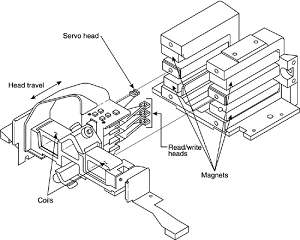Linear Actuators
A linear actuator moves the heads in and out over the platters in a straight line. The coil moves in and out on a track surrounded by the stationary magnets. The primary advantage of the linear design is that it eliminates the head azimuth variations that occur with rotary positioning systems.
Azimuth refers to the angular measurement of the head position relative to the tangent of a given cylinder. A linear actuator does not rotate the head as it moves from one cylinder to another, thus eliminating this problem.

Although the linear actuator seems to be a good design, it has one fatal flaw: The devices are much too heavy. As drive performance has increased, the desire for lightweight actuator mechanisms has become very important. The lighter the mechanism, the faster it can accelerate and decelerate from one cylinder to another.
Because they are much heavier than rotary actuators, linear actuators were popular only for a short time; they are virtually nonexistent in drives manufactured today.
Rotary actuators also use stationary magnets and a movable coil, but the coil is attached to the end of an actuator arm. As the coil moves relative to the stationary magnet, it swings the head arms in and out over the surface of the disk.
The primary advantage of this mechanism is its light weight, which means the heads can accelerate and decelerate very quickly, resulting in very fast average seek times. Because of the lever effect on the head arm, the heads move faster than the actuator, which also helps to improve access times.
The disadvantage of a rotary system is that as the heads move from the outer to the inner cylinders, they rotate slightly with respect to the tangent of the cylinders. This rotation results in an azimuth error and is one reason the area of the platter in which the cylinders are located is somewhat limited.
By limiting the total motion of the actuator, the azimuth error is contained to within reasonable specifications. Virtually all voice coil drives today use rotary actuator systems.